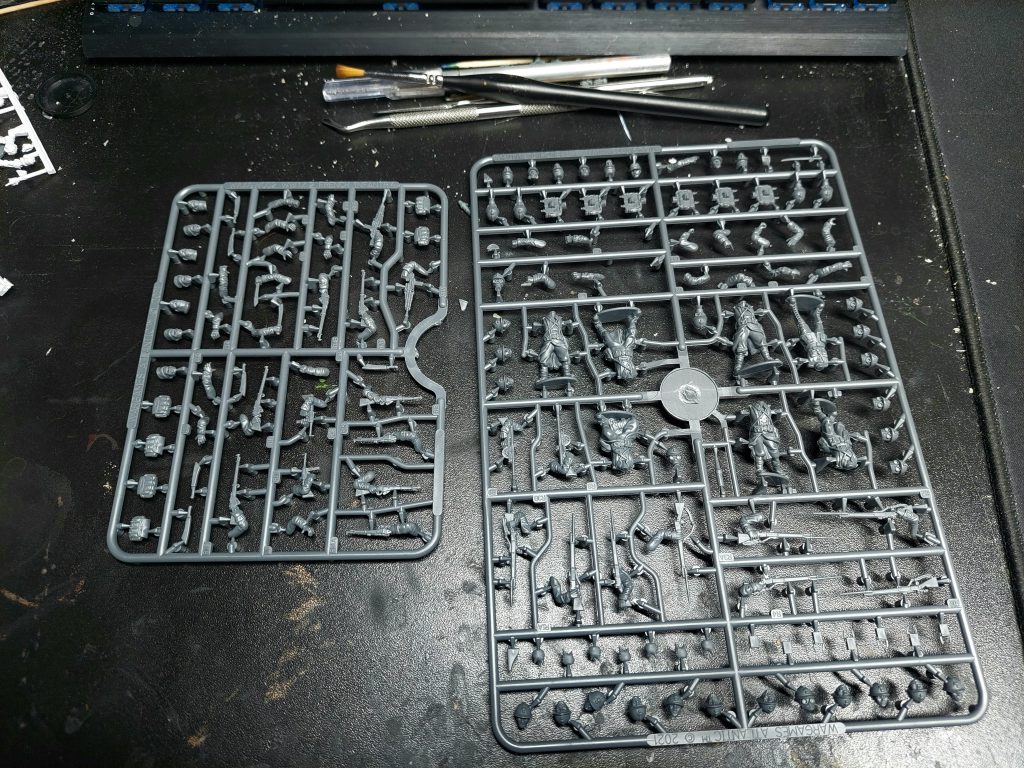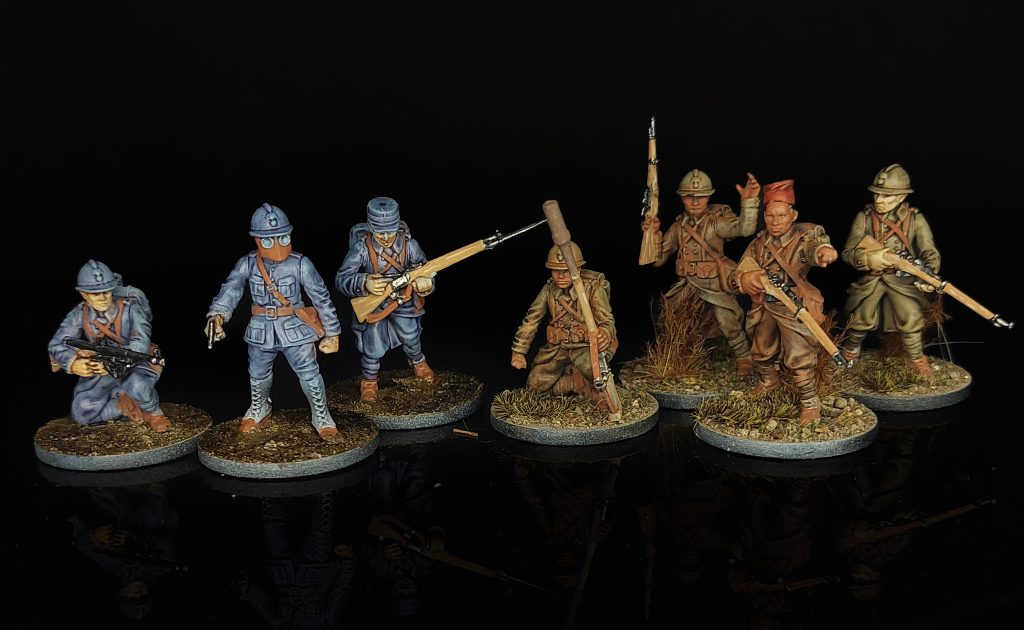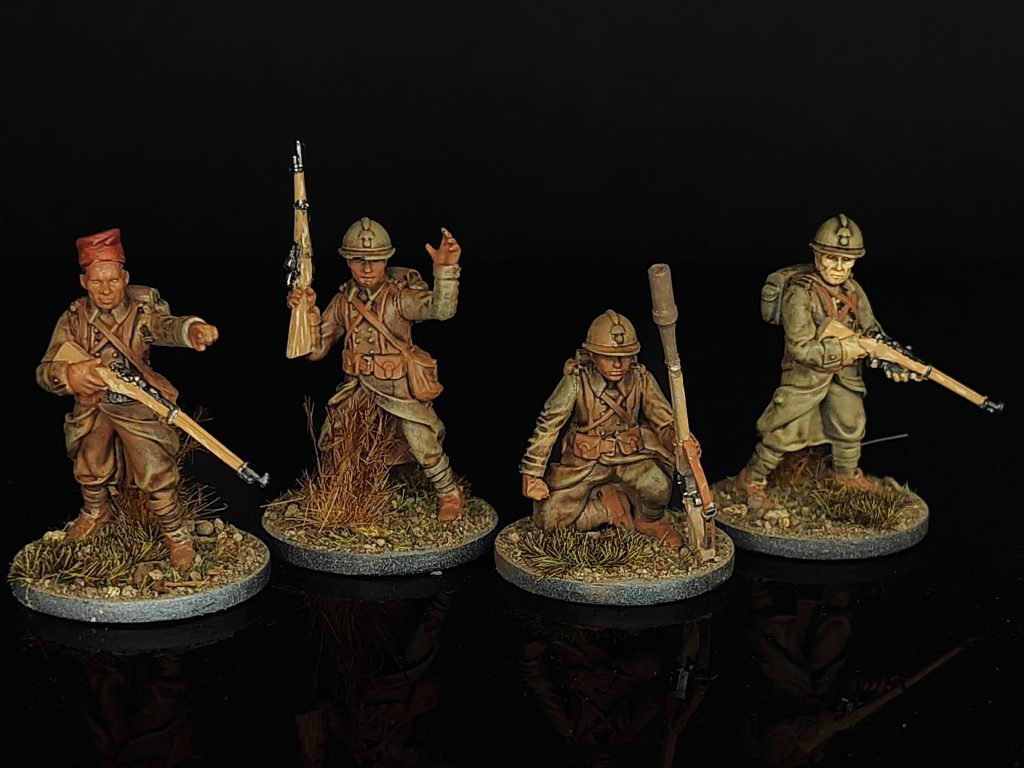This week the Goonhammer Historicals crew turned their (somewhat) expert eyes to the French Infantry (1916-1940) plastic kit. This is a versatile kit with a lot of options, so along with a review of the models we’ll take a look at a few of the ways you can build and paint them.
We’ve been pretty favourable to Wargames Atlantics kits in the past, and with good reason. The Aztec kit was so cool, we decided to write an entire game to use the models with. The Conquistador box proved a hugely versatile range of models, perfect for both historical and fantasy games. Let’s see how their French infantry stack up.
This article contains an affiliate link.
What’s in the box?
While WGA could easily have opted to split their French infantry into two boxes – one for WW1, and one for WW2, they instead opted to just do a single box that included options for both. Given that the uniforms differ only in some very specific details and colours it’s a logical decision, but an unusually generous one for a miniatures company.
Each box contains two sets of sprues – five standard ones and five half-size ones. The big sprue contains bodies (one piece torso and legs) for both periods, as well as arms, weapons, heads, backpacks, VB grenades and pouches. The smaller sprue is mostly the WW2 compatible weapons and backpacks, but also chèche heads for Senegalese Tirailleurs. The bodies can make five basic infantry (with greatcoats), and one officer (without greatcoat), making for a total of 25 infantry and 5 officers. That’s enough for a full platoon of French for most games, though for Chain of Command you might need a second box to fill out the larger infantry squads and provide more non-officers/VB grenade launchers.

As with all the WGA kits I’ve had, the amount of extra bits they give you is frankly ridiculous. Each of the big sprues contains 33 different heads, and the small sprues contain another 6 each. That’s 195 heads per box, enough to trivially equip every soldier with all of a particular set (M2 masks, ARS masks, adrian helmets, képis, Senegalese chèche, Harlem Hellfighters), and still have a metric boatload left over. This extends to the arms, backpacks, pouches, weapons – lots of fodder for your bits box.
This does come with something of a downside, however, as the box contains no instructions at all. Expect to spend a considerable amount of time clipping arms off the sprue, mixing and matching until you find ones that can actually hold the rifle up. If you want to be really accurate and make sure all your rifles, backpacks and heads fit the period you’re going for you’re going to need to acquire some Osprey books or some-such, or alternatively read the rough guide later in this article.
All the bodies come on little integrated puddle bases, but no proper bases are included in the box (I do actually recommend WGA’s own 25mm bases, which are doubled-sided to allow for both puddles and no puddles).
Casting quality is good, with no flash and relatively unobtrusive mould lines. Unfortunately what lines there are often cross over textured areas, making it awkward to clean them off.
Sculpts

This might be one of the most nicely sculpted and versatile historical kits I’ve ever worked with.
Obviously you get a huge quantity of varied bits, but they’re also modular enough that you can mix and match parts to your leisure. It’s very rare indeed that you’ll try a compatible set of arms and find that it just won’t fit this particular body piece. I’ve put together a whole platoon, and have managed to almost never repeat poses. All of the poses you can make are very naturalistic, with nothing standing out as too stiff or too action movie.
The detail on the bits is impressive, though they’re not so busy that they become a pain to batch paint. The models are well proportioned and detailed, they’re easily the best early war French miniatures you can buy. All other options I’m aware of are in metal, and tend to be chunkier and less detailed, and substantially more expensive to boot. My main complaint with the sculpts is actually the VB rifle grenades. They look great but have no slot that fits over the ends of the rifles, requiring a very fiddly bit of drilling. so the VBs can easily end up getting crooked or becoming detached. I’m also not a huge fan of all of the machete wielding arms for the Tirailleurs, because it’s part of a modelling trend for colonial units I quite dislike, but there’s more than enough arms in the box to make these completely optional.
You might have some small gaps between arms and torso, but given the foldiness (shut up, it’s a word) of the greatcoats this doesn’t stand out particularly. The heads are pretty much seamless, having a little shelf that slots over the neck like the recent Deaths Korps of Krieg plastic kit.
Conclusion
Simply put, this is the best value and quality of miniature you can possibly get for French infantry, domestic or colonial, for WW1 and WW2. It’s obvious a huge amount of research and effort has been put into getting all of the kit just right, and covering almost every possible permutation of the infantry loadout. As someone who’s really passionate about representing combat forces that weren’t just white dudes, I really appreciate the sheer amount of heads and bits that can reflect those units. The sculpts are both high quality and versatile, and they’re easy to paint up quickly.
The kit costs £25 in the UK, and it’s an absolute steal. Buy this, some support weapons and maybe a tank or two and you’ve got a full sized force for a platoon level game.
Building and painting your platoon
The lack of instructions in this box can make it a daunting prospect to start putting your lads together. I had to spend considerable time trawling through uniform books before I was confident to actually get started. Thankfully I can pass on this work to make it a bit easier for you.
WW1 Uniforms and Equipment

For Great War soldiers you basically don’t have to touch the half-size sprues unless you’re planning on representing Tirailleurs or other colonial troops. The big sprues contain arms with Lebel rifles (still the main infantry weapon of the French army at this point, despite the introduction of the more modern Berthier, due to its larger ammo capacity), and arms with chauchat light machine guns, the primary squad support weapon of the Great War. Worth noting that colonial units implemented the Berthier rifles en-masse, which the regular army didn’t. It also has arms carrying the Modèle 1892 revolver and the Ruby semi-auto pistol, which are good for officers and LMG loaders (who were generally not issued with rifles, as they were expected to focus on their task). We also have an arm ready to huck an F1 Grenade, which again is appropriate to WW1.
In terms of other equipment, we have the wood-framed model 1893 backpacks, which are easily recognised by the blanket that’s wrapped around the top of them. The backpacks on the other sprue weren’t introduced until the 1930s. For gas masks, we have the M2 represented (cloth mask with eye holes but no air filter), and the ARS (has an air filter, adopted from 1917 onwards). The rectangular pouch that comes with the kit was used in WW1 uniforms as a cartridge pouch.
For headwear the képi (the ones that look like civil war slouch caps) or the classic Adrian helmet are both appropriate for the period. The Senegalese chèche are here in abundance, but there’s no real evidence that Tirailleur units would have actually worn these in the field. Almost all photos of them wearing them are from parades or rearline duty, and in combat they seemed to just wear the Adrian helmet but with an anchor symbol stamped on that indicated they were colonial troops. Using the heads with chèches to identify NCOs, officers and engineers is a good way to get them into your force in a more realistic way, if you care about that sort of thing.
Domestic French infantry wore horizon blue uniforms at this time, but colonial troops generally wore khaki uniforms with khaki or olive green helmets.
WW2 Uniforms and equipment

The French army was, on paper, one of the most technologically advanced in terms of basic equipment by the eve of WW2. The problem, of course, is that very few of their units were actually fully equipped with the latest stuff. The M34 and MAS36 bolt-action rifles, MAS-38 SMGs and MAS40 semi-auto rifles were state of the art, but most units were still using either Berthier, and in some cases the Lebel. The FM1924/29 LMG had been more widely equipped, but was still not universal.
Anyway, on the small sprues we have four different weapons for WW2 units – the Berthier rifle, the Berthier carbine, the FM24/29 LMG and the MAS-38 submachine gun. In a standard French squad there would be an FM24/29, a loader armed with a Ruby pistol, three carbine armed soldiers who carried extra ammo for the squad, and six full-length rifles. The backpacks on the half-sprue were introduced in the ‘30s, so they work well for WW2 forces.
Don’t feel you have to be too strict with this equipment. As mentioned the French army was very spottily equipped, so having a few Lebels, old backpacks and even horizon blue helmets here and there would not be out of place, and might spice up the look of your squads a bit to boot.
All standard infantry, colonial and domestic, wore khaki uniforms and khaki or olive green helmets.
Have any questions or feedback? Got some great ideas for how you’d use this kit? Drop us a note in the comments below or email us at contact@goonhammer.com If you’d like to pick up this, or any other Wargames Atlantic kit AND support goonhammer at the same time, access their site through this affiliate link.



You must be logged in to post a comment.